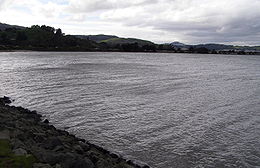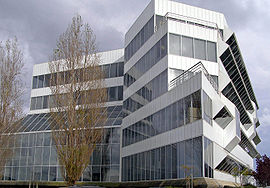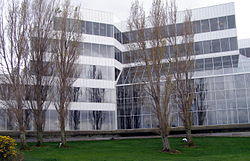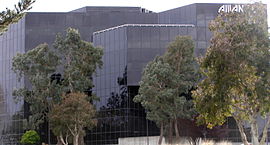- Dakin Building
-
Coordinates: 37°40′36″N 122°23′03″W / 37.676667°N 122.384167°W
The Dakin Building is an architectural award-winning class A office building on the San Francisco Bay in Brisbane, California. Serving as a corporate headquarters building for several companies of national prominence, it was built from the profits of the Garfield character whose licensed products of the R. Dakin Company soared in sales in the late 1980s. Located on Sierra Point, it became a landmark in the San Francisco Bay Area for its distinctive design and was nicknamed the Luke Skywalker building for its dramatic posture overlooking the bay, in contrast to its ominous looking neighbor office building that was nicknamed the Darth Vader building.
Contents
Awards
The Dakin building has won a number of architectural awards including an American Institute of Architects Design Excellence Award in 1992.[1] According to the San Francisco Examiner the jury awarded this distinction to the Dakin building because "Its chief strength is the atrium, with its views of the San Francisco Bay and asymmetrical skylight". The same newspaper article noted that the building "houses executive offices, research and development facilities and product showrooms". Further in the same newspaper article, it is noted that the Dakin building was built over thick bay mud formations that are expected to subside up to ten feet by the year 2006; therefore, the main entrance ramp was built on a giant hinge to allow the earth to settle, while the building, resting on driven piles, remains stationary. The year 2006 has arrived, and indeed the flexibility in the ramp allowed the building to effectively "rise" above the land around it. However, the subsidence undermined the safety of the ramps causing structural damage to the concrete and opening up small crevice-like cracks in its connective fabric. Their angle eventually violated city regulations for disabled-person access and in October, 2006 the ramps were replaced with a composite design of stairs, disabled-access lift, and switchback ramps.
In international design competition the Dakin building was awarded semi-finalist standing in the 1990 Quaternario Award, an international award for innovative technology in architecture.[2] The American Institute of Architects 1990 article states that one of the bases for the international recognition is: “The two north facing atrium walls are faced entirely in glass... Due to the expanse of glass, the projecting atrium gives the impression of a greenhouse, creating the effect of extending the interior to an adjacent park and to the bay beyond”.
The Quaternario judges focused on the technological aspects of the fenestration design where window angles were calculated to minimize interior glare and reduce interior over-illumination, while at the same time reducing solar heat loading and subsequent demand for air conditioning as energy conservation techniques. The angled window projections effectively provide permanent sunscreens, obviating any need for interior blinds or shades.
Ownership and history
The Dakin Building was constructed in 1986 under commission of the R. Dakin Company, one of the largest manufacturers of plush products (mainly teddy bears) in the United States at that time. Dakin was in a large upswing of sales and profits in the late 1980s fueled by success of its Garfield character licenses, and needed to accommodate its burgeoning staff of artists and designers. Not long after completion of the building, several of the company founding key executives were killed in a light aircraft accident.
In a financial and sales tailspin, the R. Dakin Company proceeded to sell this headquarters building to C. Michael Hogan, president of Earth Metrics Inc., an environmental research and consulting firm. Earth Metrics then moved into two floors of the building, as Dakin compressed its operations. At Dakin's request, The Good Guys! were secured as a major tenant in 1992, and the new owner performed substantial tenant improvements of approximately $1,300,000, upgrading the computer room infrastructure and building an auditorium.
The Foster Company purchased the entire holding in 1995. The Foster Company is the successor entity of T. Jack Foster, a wealthy real estate magnate, for whom Foster City, California is named, since Foster owned and developed most of that San Francisco Peninsula city of population around 30,000.
The current tenant is Walmart.com, the Web site division of Wal-Mart.
Siting and physical design
The building is situated on a San Francisco Bay shoreline frontage parcel with almost one quarter of a mile of bay frontage. The 8-acre (32,000 m2) parcel at Sierra Point has a commanding view of the central portion of the San Francisco Bay, the city of San Francisco, San Bruno Mountain and Candlestick Park. The Dakin Building is in proximity to the Sierra Point Marina and lies about four miles (6 km) north of San Francisco International Airport.
The underlying site was constructed from bay fill activities from 1965 to 1985, mostly consisting of construction debris from San Francisco. Aerial photographs prior to 1965 show this area to be tidelands of the San Francisco Bay. A clay cap was constructed over the debris prior to building approval.[3]
The building was designed by the well known architectural firm Munselle Brown Partnership Inc. of San Francisco who were selected after winning an invited design competition, and Architects of Record, DES Architects + Engineers, Inc. as a Class A office building.[4] . Peter Munselle of the Munselle Brown Partnership prepared the winning architectural design concept. Theodore Brown served as Partner in Charge for Munselle/Brown and Bob Giannini was the principal architect for DES. The building was completed in 1986, commissioned by the Dakin Company, being constructed by the Koll company. It is entirely steel frame in construction supported by driven piles up to 140 feet (43 m) in depth into the bay mud. A dedicated trail for hikers is established to conform to the San Francisco Bay perimeter master trail plan; large boulders and rip-rap are placed below the trail to prevent wave action erosion. The landscape architect for the original design was Royston, Hanamoto, Alley and Abey of San Francisco.
The building itself is a five story design plus a penthouse, plus one subterranean parking level. The exterior features a skin that is an innovative all porcelain panel design, giving the appearance of shimmering in the sunlight or uplights by night; moreover most of the fenestration is slanted approximately 45 degrees from vertical, designed to reduce glare and enhance energy conservation, but also lending a futuristic effect. The gross floor area is approximately 119,000 square feet (11,100 m2) plus 21,000 square feet (2,000 m2) of underground parking and shipping /receiving rooms.[4] Surface parking is provided for 266 vehicles.
Due to its proximity to landfill, the Dakin relies on specially engineered recovery systems below its basements to actively capture fugitive methane off-gas and vent it away from the building.
The interior design features a soaring five-story entrance atrium capped by a massive skylight dome with a 40-foot-wide (12 m) laminated glass glazing panel, whose atrium footprint is almost 10,000 square feet (1,000 m2). Other major interior elements are a state of the art auditorium and a large computer room capable of supporting a national corporation data center, both built by C. Michael Hogan, the second owner.
At the Christmas season the building was historically topped with several illuminated stars approximately 70 square feet (7 m2) each in area, emulating a Brisbane annual tradition of lighted stars on buildings.
Role during Glasnost
During the Glasnost period, the Dakin building was a primary location central to development of relationships between Russians (then Soviet citizens) and Americans. Philanthropist Henry Dakin, chairman of the Dakin Company, was the catalyst in bringing numerous parties together from the Soviet Union and United States. As reported by the San Francisco Chronicle:[5] "During the late 1980s, as glasnost and perestroika led to the liquidation of the Soviet empire, the Dakin building was the location for a series of groups facilitating United States-Russian contacts. They included the Center for U.S.-U.S.S.R. Initiatives, which helped more than 1000 Americans visit the Soviet Union and more than 400 then-Soviet citizens visit the U.S."
The R. Dakin art collection
In the late 1980s the R. Dakin Company assembled a large collection of contemporary art from artists worldwide. The media included watercolor, oil painting, serigraph, lithograph, etching, collage, ceramic plate, sculpture and mixed media. These pieces were used to grace the interior of the Dakin Building, and were hung in literally all public areas, conference rooms, hallways and the atrium. The collection featured some well known artists and some rising artists, who were not well established at that time. Some of the artists featured are Jeff Glenn, tapistry artist; Barbe; Marachal; Heiliger; Marlatt; Frings; Dudley and Garber. When C. Michael Hogan purchased the building in 1990, he hung some of his art collection to add to the museum character of the building, including a well known suite of Roberto Matta. When Dakin left the building, Hogan purchased the bulk of the Dakin art collection.
The front exterior entrance to the Dakin building originally featured a large stone sculpture of a teddy bear, hewn from natural stone. This bear became the hallmark of the high-tech building embodying the playful spirit of the R.Dakin designers and the avant-gard character of the building. The bear is designed in the manner of Benny Bufano by sculptor Judith Lord. When Hogan sold the Dakin Building in 1995, he retained ownership rights to the bear.
The Star Wars saga
The Dakin building has been widely labelled the 'Luke Skywalker' building,[6] due to its bold appearance of bright white porcelain panels and futuristic design, seeming to embody the concept of good. To complete the metaphor the nearby, ominous looking, high-tech building is dubbed the 'Darth Vader' building,[citation needed] replete with its full reflective exterior of black smoke glass, emulating the impenetrable visage of the evil counterpart.
The April 17, 1986, San Francisco Chronicle article cited above notes: "Aesthetically [the Darth Vader building] is no match for Luke Skywalker's happy white palace just a few hundred feet away, which has been an instant popular success. The newly completed building is headquarters for the R. Dakin cuddly toy company."
According to the San Francisco Chronicle article, "The differences between the two buildings go far beyond ... architectural good versus evil. They show the choice between prepackaged architecture, in which individuals or even businesses are regarded as interchangeable, and a custom built home for a family controlled company that has been in the Bay Area for years."
 Looking northwest over San Francisco Bay toward San Bruno Mountain. This arm of the bay is the location where Humphrey the whale was rescued.
Looking northwest over San Francisco Bay toward San Bruno Mountain. This arm of the bay is the location where Humphrey the whale was rescued.
References
- ^ Judges praise innovative ideas, San Francisco Examiner, Page F-6, January 12, 1992
- ^ Dakin building, San Francisco, California, Architecture: The Magazine of the American Institute of architects, volume 79, number 8, August 1990
- ^ Paul B. Awosika and Marc Papineau, Phase One Environmental Site Assessment, 7000 Marina Boulevard, Brisbane, California, Certified.Engineering & Testing Company, Boston, Massachusetts, July 15, 1993
- ^ Dale H. Duffy and Kendall W. Rice, Level One Environmental Site Assessment, 7000 Marina Boulevard, Brisbane, California, prepared by E2C Inc., Sunnyvale, California for C.M. Hogan, November 28, 1990
- ^ "Cyberspace", San Francisco Chronicle, Page A-14, November 20, 1995
- ^ An architectural Star Wars clash at Sierra Point, San Francisco Chronicle, News Page 4, April 17, 1986
See also
- Porcelain
- Efficient energy use
- Solar design
Categories:- Futurist architecture
- Buildings and structures completed in 1986
- Buildings and structures in San Mateo County, California
- Brisbane, California
- Postmodern architecture in California
Wikimedia Foundation. 2010.




